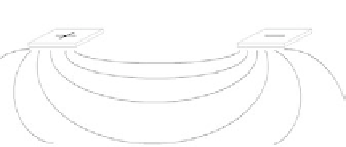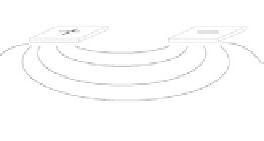Biomedical Engineering Reference
In-Depth Information
electrodes
muscle
current
Figure 7.2
Current flowing through muscles with electrodes further apart gets deeper into
muscle tissues compared to when the electrodes are closer together.
movement through muscle tissue (Sisto, 2009). Electrodes closer to each other
allow the current to travel more superficially. Electrodes spaced further apart
The electrode pairs could be surface electrodes which are the most commonly
used for FES. Also, percutaneous electrodes (i.e. implanted in the muscle and
exiting through the skin) or implanted electrodes, (i.e. completely implanted in
the person's spinal roots) with radio frequency control outside the body could be
used (Peckham1987; Stein, 1992; Sisto, 2009). Implanted electrodes always provide
greater precision of muscle movements; however the procedure is more invasive.
7.3.5 FES Muscle Fatigue and Muscle Fibre Recruitment
Onset of fatigue occurs faster during FES contractions than voluntary movements.
During voluntary muscle contractions, individual motor units are activated inde-
pendently at different times and rates leading to an asynchronous muscle fibre
contraction pattern (Baker, 2000) and a reduction in fatigue. Additionally, motor
fibre recruitment order via FES is the reverse of voluntary recruitment order,
further accelerating fatigue. Motor units are recruited according to motor neurone
position and geometry, with respect to the electrodes, as well as fibre size. During
FES the large fast twitch fatigable units are recruited first and small slow twitch
fatigue resistant units are recruited last (Hamada, 2004). This is because the
electrical stimulation thresholds for the large neurons, which innervate the fast
twitch fibres, are lower than for the small neurons which innervate the slow twitch
motor units (Eccles, 1958).
As stimulation pulse intensity is increased, additional motor units are
recruited. As more motor units are recruited and contribute to the contraction
there is a non-linear increase in the force produced by the muscle (Kralj, 1989).
If the stimulation intensity is high enough fibres from antagonist muscles may
accidentally be recruited (Levin, 2000). At a given electrical muscle stimulation
intensity there are no alterations in motor unit recruitment. Both the rapid fatigue
during FES and the condition of paralysed muscle limit the functional outcomes or
training benefits potentially delivered by any FES evoked systems (Sinclair, 1996).



























































